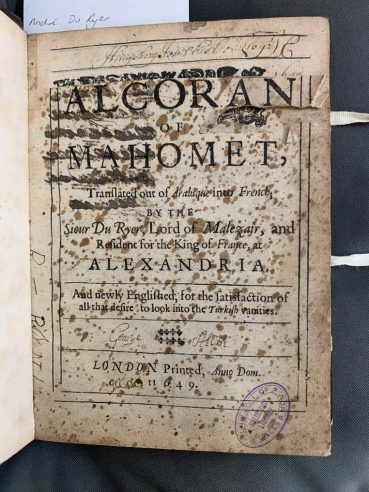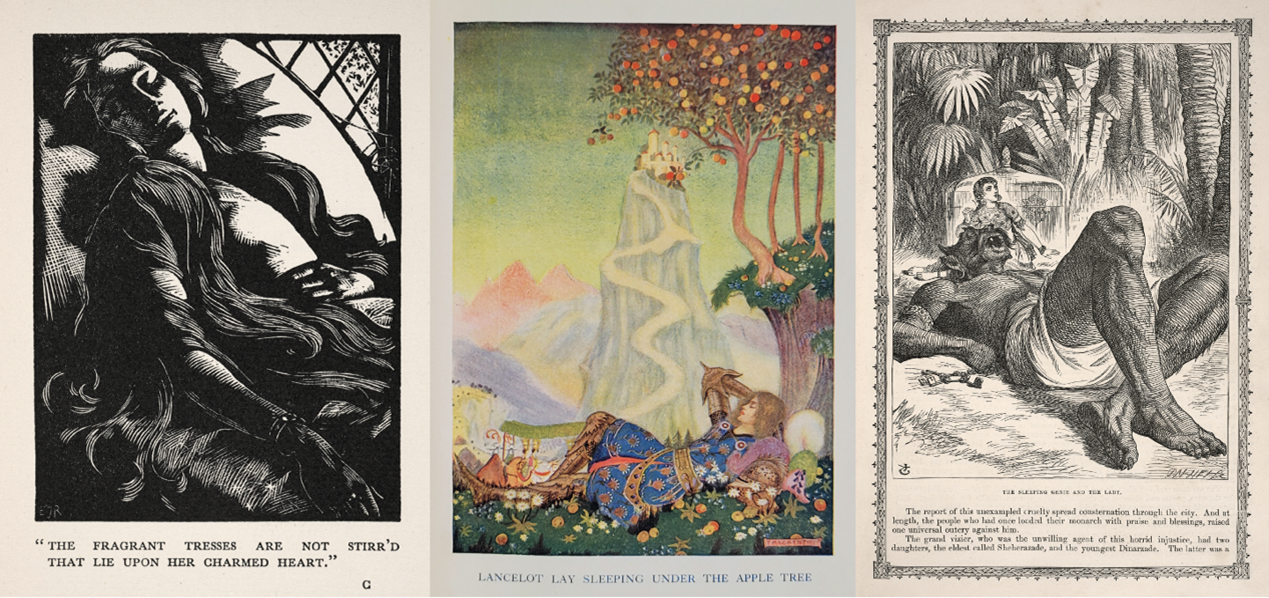Mansur Ali – The Alcoran of Mahomet in the Salisbury Collection: The Mystery Continues
26 April 2023

On Monday 13 March 2023, my colleagues from the School of English and Philosophy (Dr Megan Leitch, Dr Stephen Gordon and Prof Martin Willis) and I (Dr Mansur Ali) with the assistance of Cardiff University AHSS library special collection staff, and led by Dr Megan Leitch (Reader in English Literature), launched our exhibition on ‘Sleep and Dreams: Literature, Science, and the Supernatural’. The event was also used to introduce another project that Megan and I are working on with colleagues from Cardiff as well as other Welsh Universities (The medieval future of sleep) funded by the Welsh Crucible grant (https://welshcrucible.org.uk/what-is-welsh-crucible/).
The ‘sleep and dreams’ exhibition is the culmination of all of us rummaging through the archives and special collections of the AHSS library at Cardiff University throughout the winter months of 2022. In the days of eBooks and pdfs, touching and smelling dusty musty tattered books never felt so good.
I was surprised to have stumbled upon a copy of the first translation of the Qur’an in to English. To be fair, it was not a direct translation of the Qur’an from Arabic, but an English translation from the French translation of the original Arabic. The purpose of the translation was to make Britons aware of the evil ways of the Turks (understood as Muslims), as can be read from the full title of the translation, ‘The Alcoran of Mahomet: translated out of Arabique into French; by the sieur Du Ryer, Lord of Malezair, and resident for the King of France, at Alexandria. And newly Englished, for the satisfaction of all that desire to look into the Turkish vanities.’
The translation was published in 1649, a year that was marred with problems in British political history. It was the year Kings Charles I of the family of Stuarts was executed for treason. There was heavy infighting between Royalists and Parliamentarians. In the midst of all this political strife, the translation of the Qur’an added fuel to fire. No wonder who the exact author of the translation was is still a mystery today. Its publication caused panic in England as it did two years ago in France when it was translated from the Arabic to French by the French diplomat the sieur Du Ryer, Lord of Malezair. In Britain, the translation was discussed in parliament as to whether its publication and distribution should be banned and whether its publisher and author should be fined and punished.
The printer, John Stephenson, was brought in for investigation who revealed the name of the translator as one Thomas Ross. The latter claimed the translation was by his uncle Alexander Ross who was the former chaplain to the late King Charles I. The notes in the margins of the translation and the post-script essay also allude to this. Today, the translation is most famously attributed to him. Some scholars believe that it was written by a Hugh Ross, a distant relative of Alex and Tom Ross.
In an edition which was published 20 years later a post-script essay was added warning anyone who believed in the message of this book that their souls will be damned for eternity. This may be telling that people in Britain were being affected by the Qur’an as early as the late 1600s.
Both my colleague Lisa Tallis (special collection librarian) and I were intrigued to find this translation of the Qur’an in the Salisbury Collection of the special collections (https://xerte.cardiff.ac.uk/play_13551#page1). Enoch Robert Gibbon Salisbury (1819–90), businessman, barrister and one time MP for Chester was an avid collector of books. A colleague (Dr David Callander) later informed me that in the seventeenth century, Welsh writer Charles Edwards (https://biography.wales/article/s-EDWA-CHA-1628) published Y Ffydd Ddi-ffuant (The Unfeigned Faith), which is a well-known work of Welsh literature, charting the history of Christianity. This included an abridged translation of the Quran into Welsh.
Salisbury would certainly have been familiar with this work, and most probably Alex Ross’s translation may have been Edward’s source. This possibly creates a connection with Salisbury’s interest in early modern Welsh literature. Nevertheless, one part of the puzzle is still missing.
In the Alcoran that we have in the Salisbury Collection, there is an inscription which reads, ‘Humphrey Jones, his book, 1692′ and (1694)’. Who Humphrey Jones is and how his book came in to the Salisbury library is an added layer of mystery. The search continues.
More can be read about the Salisbury and the Salisbury collection in the following article:
Tallis, Lisa. “Bibliomania and Marginalia: Unexpected Histories in the Margins of the Salisbury Library, Special Collections And Archives at Cardiff University.” The Welsh History Review 31.1 (2022): 150-176.
More can be read about the Alcoran translation in the following article
Samir Jeraj. “The Mystery of the First English Qur’an.” Hyphen, December 13, 2022. https://hyphenonline.com/2022/12/13/the-mystery-of-the-first-english-quran/.
The sleep exhibition will run until July 2023 and is being hosted in the Special Collections and Archives Reading Room, in the basement of the Arts and Social Sciences Library of Cardiff University.

Dr Mansur Ali is Senior Lecturer in Islamic Studies at Cardiff University, with the Centre for the Study of Islam in the UK. His research interests follow two strands: Hadith Studies and Practical Theology, with an emphasis on bioethics.
- Sophie Gilliat-Ray – A Tale of Two Re-interments
- Sam Bartlett – Research Update on Islam in Wales Project
- Matthew Vince – Exploring the Rich Tapestry of Islam: Three Years of Discovering Muslims in Britain
- Laiqah Osman – Things to consider when applying for a PhD, from a PhD student
- Sophie Gilliat-Ray, Mansur Ali, and Hansjoerg Schmid: Research Update
- April 2024
- March 2024
- June 2023
- May 2023
- April 2023
- March 2023
- February 2023
- January 2023
- December 2022
- October 2022
- February 2022
- September 2021
- July 2021
- February 2021
- December 2020
- November 2020
- July 2020
- June 2020
- May 2020
- February 2020
- July 2019
- March 2019
- February 2019
- November 2018
- July 2018
- June 2018
- April 2018
- January 2018
- October 2017
- August 2017
- July 2017
- June 2017
- April 2017
- July 2016
- March 2016
- April 2015
- March 2015
- February 2015
- December 2014
- November 2014
- October 2014
- September 2014
- August 2014
- April 2014
- March 2014
- January 2014
- December 2013
- November 2013
- October 2013
- September 2013
- June 2010